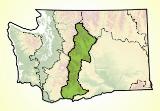 © Pete Saloutos/Panoramic Images (Washington Title Image Large)
© Pete Saloutos/Panoramic Images (Washington Title Image Large)

East Cascades: People in the Ecoregion
For at least 11,000 years, tribes from as far as Alaska, California and the Great Plains gathered just east of the Cascades to trade and fish at Celilo Falls. This productive and culturally important fishing site was inundated by the Dalles Dam in 1957.
The eastern flanks of the Cascades have long been inhabited by the Wenatchee, the Chelan, the Kittitas, and the Yakama. Tribes of the region gathered in longhouse communities for the winter and traveled regionally from spring to fall.
People used the Cascades for hunting, fishing, and harvesting plant foods. Camas bulbs and biscuitroot are key ingredients for a traditional bread. Tribes also traveled through the Cascades to visit and trade with neighboring tribes on the west side of the mountains.
Naches Pass in the East Cascades saw the first crossing by a wagon train in the fall of 1853. Settlement along the East Cascade front began about 25 years later.
Farmers in the semi-arid valleys developed their land with irrigation, and the area became well known for its bountiful fruit orchards. The climate also suits vineyards, and that industry has grown in recent years. Grazing and ranching are common land uses as well.
Logging in the East Cascades’ montane forests began more than a century ago and remains an important livelihood.
From the 1880s through the 1930s the northern end of the ecoregion saw a mining boom. The mountains were scoured for gold, copper and coal.
The towns of Roslyn and Cle Elum were coal mining centers. Miners representing over 20 different nationalities worked in the area between 1886 and 1929. The last coal mine closed in 1963.
Along the Columbia River, hydroelectric development made Wenatchee claim itself Washington’s “power belt.”
Today roughly three quarters of the East Cascades ecoregion is publicly owned, much of it by the US Forest Service. Several wilderness areas, including the Alpine Lakes, Norse Peak, Goat Rocks, and Mount Adams, offer protected high elevation habitats for wildlife.
The Yakama Nation, a major landowner, stewards its lands on the eastern slopes of Mount Adams. Washington State manages more than 113,000 acres as well, including the Colockum, Oak Creek, and Chelan Butte Wildlife Areas managed the Department of Fish and Wildlife.
Some two thirds of the area’s important river bottom corridors for anadromous fish are owned privately. This highlights the importance of cooperative public-private efforts, such as the Tieton River Canyon Partnership.
For details of this ecoregion within Washington, click a subheading in the left column.
View the more general description of this ecoregion in North America



